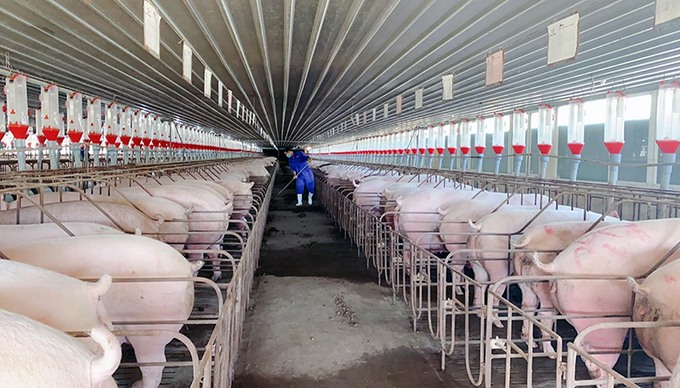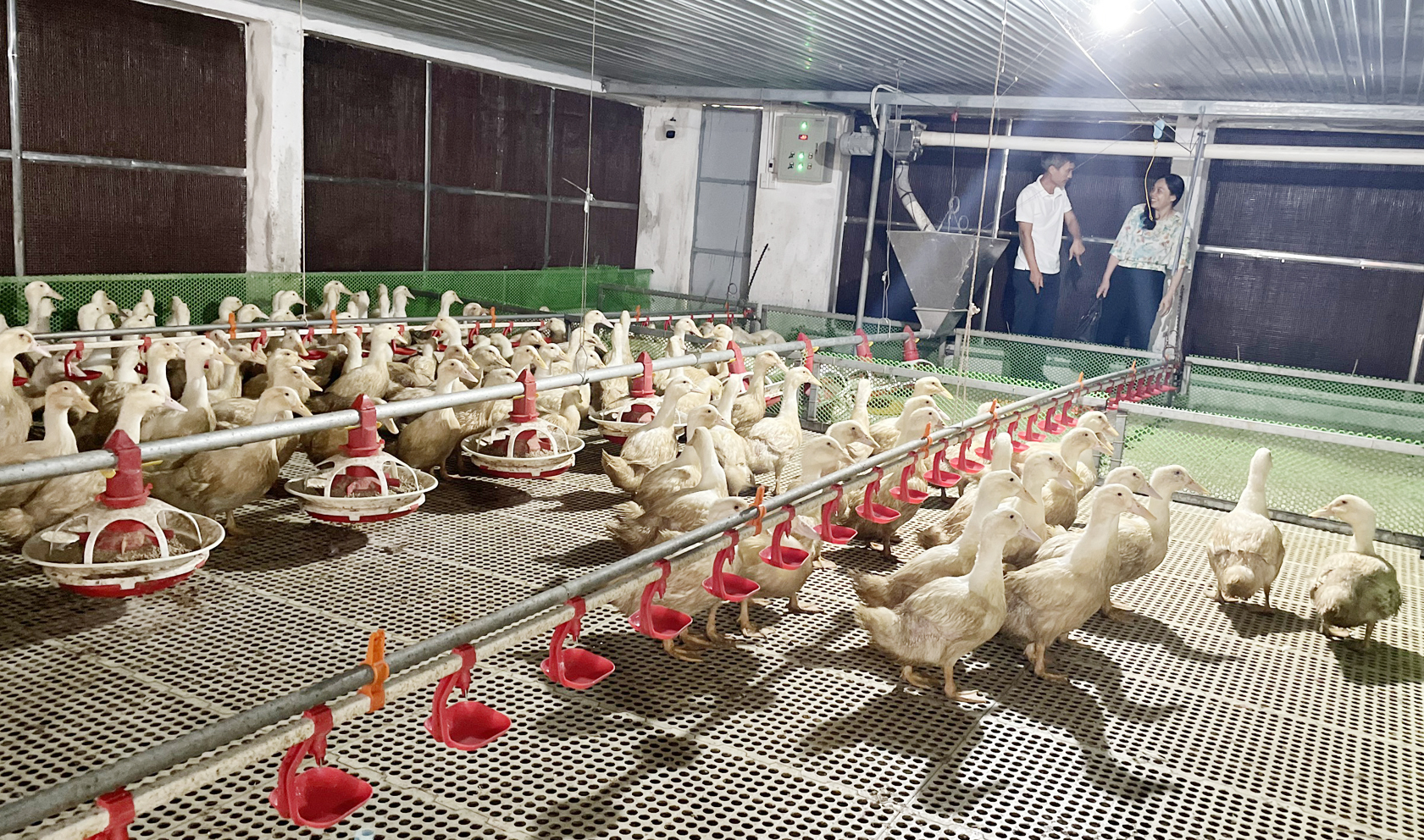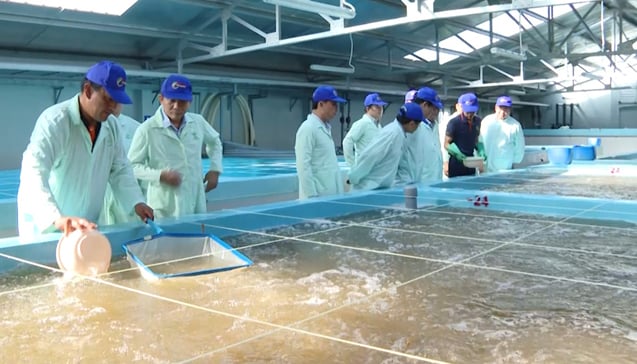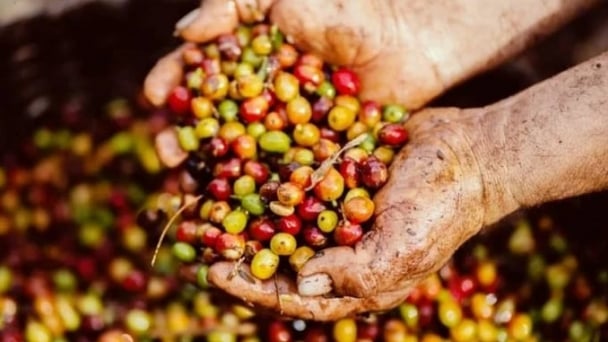June 17, 2025 | 19:46 GMT +7
June 17, 2025 | 19:46 GMT +7
Hotline: 0913.378.918
June 17, 2025 | 19:46 GMT +7
Hotline: 0913.378.918
Recently, the Quang Binh Provincial Agriculture and Fisheries Extension Center has replicated many potential models in livestock, crop, and aquaculture, notably high-technology applications in production. Thanks to that, productivity and product quality, and economic efficiency increased significantly. This helps Quang Binh products become competitive in the market, changing the face of agriculture in many localities.
In Quang Trach district (Quang Binh), the high-tech membrane house model of Hung Loan Clean Agricultural Production and Services Cooperative (Hung Loan Cooperative) with an area of 8 hectares highlights changes in local agricultural production.

Model of high-tech melon growing greenhouse in Quang Trach district. Photo: T. Phung.
The cooperative has invested in two greenhouses to grow melons and vegetables according to VietGAP standards. Ms. Vo Thi Anh, a member of Hung Loan Cooperative, says that this is one of the models that benefit from the greenhouse support policy implemented by the Provincial Agriculture and Fisheries Extension Center.
“High-tech application has created products with high productivity and quality, ensuring food hygiene and safety. Therefore, consuming the cooperative’s products is more convenient, bringing higher income and efficiency than traditional production,” Ms. Anh says.
Through the production process, a greenhouse with an area of 800m2 produces over 2 tons of melons per crop. On average, each fruit weighs 1.5 - 2kg, with selling prices ranging from 40 - 60 thousand VND/kg, earning about 100 million VND. Hung Loan Cooperative’s melon products have spread to all provinces and cities nationwide and are highly appreciated by the market. The products delivered to consumers must meet cleanliness and quality criteria.
In early 2023, the Quang Binh Agriculture and Fisheries Extension Center also supported Nhat Minh General Trading Company Limited (Nhat Minh Company) in Van Ninh commune (Quang Ninh district) to invest in building three closed cages to raise chickens. Using high technology with a scale of 4,900 animals. Initial results show that economic efficiency is superior to traditional chicken-raising methods.
Mr. Tran Thanh Ngoc, Director of Nhat Minh Company, says that with an area of more than 1 hectare, the Company mainly traditionally raised chickens in the past. Hence, the productivity was low, the breed quality was poor, and it was difficult to control. Disease control consumes a lot of labor costs in nursing care and affects the surrounding environment.

Applying high technology in chicken farming at Nhat Minh Company. Photo: T. Phung.
When the Company received partial financial and technical support from the Quang Binh Agriculture and Fisheries Extension Center, the chickens were raised on biological bedding, automatic feeding and drinking water systems, and spacious, airy barns. In addition, the Company has invested in additional food warehouses, hatching areas, and egg incubation systems to ensure a capacity of 50,000 - 70,000 eggs. The company also purchased automatic vaccination machines to serve high-tech chicken farming.
According to Mr. Tran Thanh Hai, Director of the Quang Binh Agriculture and Fisheries Extension Center, the province has quite favorable natural conditions for developing commodity-oriented chicken farming. However, localities are developing spontaneously, fragmented, and small, with no long-term orientation.
On the other hand, breeding techniques have not been paid attention, so efficiency is low and unstable. “Therefore, raising chickens using high technology is a clean farming process, disease-free, ensuring food safety, creating good quality breeds, not polluting the environment, creating momentum for commodity livestock.” Mr. Hai says.

The support from agricultural and livestock extension programs and projects applying high technology in Quang Binh have changed the province significantly. Photo: TL.
In Le Thuy district, the Quang Binh Agriculture and Fisheries Extension Center also supported An Viet High-Tech Agriculture Company Limited (An Viet Company) to invest in 2 duck cages applying high technology with a scale of 15,000 commercial ducks.
Mr. Thai Hoa Nam, Director of An Viet Company, says: “We built a large-scale food warehouse to ensure supply for 15,000 commercial ducks per batch, built a 1,800m2 biogas tank to process livestock wastewater. To ensure the environment, we deodorize by neutralizing H2S and NH3 gas precipitation.” After 45 days of raising, the ducks have reached a weight of over 3.3kg/head, meeting the standards for sale. If it turns around, it can raise and sell 5-6 batches of commercial ducks yearly, with an annual profit of about 700 million VND.
According to the Quang Binh Agriculture and Fisheries Extension Center, the province has 190 high-tech production facilities. In particular, the proportion of livestock and aquaculture establishments increased significantly in the direction of production and processing. In cultivation, there are 88 establishments; livestock has 53 establishments, aquaculture has 36 establishments; forestry has three establishments; and agricultural, forestry and fishery product processing 10 establishments.
Agricultural production facilities applying high technology mainly include: Technology for growing in greenhouses, net houses with temperature, humidity, and light adjustment; growing plants on substrate; Israel’s water-saving irrigation technology; organic and hydroponic farming processes; Microbiological technology in the production of edible mushrooms and medicinal mushrooms; Modern, closed, air-conditioned barn system; automation in providing food and water; technology for mass reproduction; biotechnology in environmental treatment of ponds and post-production wastewater treatment; automate power and food supplies; tissue culture and water-saving irrigation technology; Freezing drying system for agricultural products and medicinal materials; Use software and electronic diaries to track the production process, trace product origins... All of which support producers, bringing high economic efficiency.

The high-tech duck farming model brings an annual profit of about 700 million VND in Le Thuy district. Photo: T. Phung.
To further apply high technology in agriculture, the Department of Agriculture and Rural Development of Quang Binh has directed its affiliated units to support households, cooperatives, and businesses in the area.
Mr. Tran Dinh Hiep, Deputy Director of the Department of Agriculture and Rural Development of Quang Binh, says that not only farming, animal husbandry and aquaculture, but also high-tech agriculture has been widely applied to processed products, creating significant value for farmers and investors.
“The important thing is that applying high technology has helped provide quality and safe agricultural products, adapt to climate change, serve people's needs and move towards export. This is also a sustainable development trend, consistent with the orientation of high-tech agricultural development in Quang Binh,” Mr. Hiep emphasized.
Also according to Mr. Hiep, in recent years, the Quang Binh agricultural industry has supported investors in implementing VietGAP certification for 64 facilities, including 46 cultivation facilities, 15 livestock facilities, and 1 aquaculture facility and 2 seafood processing facilities.

High technology application in the fisheries sector in Quang Binh has also seen many positive changes in recent years. Photo: Tam Phung.
There are also 13 business locations certified to provide safe agricultural, forestry and fishery food supply chains with 20 certified products and more than 40 food production and trading establishments with 90 agricultural, forestry and seafood products have QR Code traceability stamp system built and 14 products registered for intellectual property protection.
“Despite great progress, organic agriculture and high-tech applications in the province still face many challenges because there is no specific policy and lack of financial resources, so implementation is difficult,” Mr. Hiep says.
Translated by Quynh Chi
![Turning wind and rain into action: [5] Hue applies modern technology in disaster forecasting](https://t.ex-cdn.com/nongnghiepmoitruong.vn/608w/files/news/2025/06/17/z6704423696987_15fd32ffc26d590d204d520c9dac6786-nongnghiep-093938.jpg)
(VAN) In Hue city, modern technology has recently been applied in meteorological and hydrological forecasting and warning, helping to reduce the damage caused by natural disasters.

(VAN) A cutting-edge farming technique being implemented on an experimental ranch in Arizona's Sonoran Desert has already saved a billion gallons of water over five years, according to Civil Eats.

(VAN) Poultry and pig production and the environment can be boosted through enhanced water technology, according to new research.

(VAN) Coffee prices on June 16, 2025 are unchanged. In Vietnam, local trading prices are holding steady, ranging around VND 112,000 – VND 112,500/kg.
![Turning wind and rain into action: [4] Bringing climate bulletins to remote and isolated areas](https://t.ex-cdn.com/nongnghiepmoitruong.vn/608w/files/linhnhp/2025/06/14/1152-z6704423696987_15fd32ffc26d590d204d520c9dac6786-nongnghiep-151141.jpg)
(VAN) The Vietnam Agriculture and Nature Newspaper interviewed Mr. Vu Thai Truong, Acting Head of Climate Change and Environment at UNDP Vietnam, to gain deeper insight into how climate bulletins are delivered to farmers.

(VAN) In Tien Giang, a high-tech shrimp farm has developed a distinctive energy-saving farming model that has yielded promising results.
![Turning wind and rain into action: [3] 300.000 farmers benefit from agro-climatic bulletins](https://t.ex-cdn.com/nongnghiepmoitruong.vn/608w/files/news/2025/06/12/e5a48259d6a262fc3bb3-nongnghiep-125122.jpg)
(VAN) The agro-climatic bulletin has become a valuable tool for farmers in the Mekong Delta. After more than five years of implementation, the initiative is gradually being expanded nationwide.